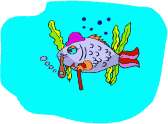|
Submitted by Ned Kehde - August 3, 2000
Until several weeks ago, many white bass anglers
in these parts had been plagued for months with a sour taste
in their mouths and dolor dispositions.
Part of this problem stemmed from columnaris, a bacterial
infection, that
killed thousands of white bass in June of 1999.
Fisheries biologists estimated that at least 50,000 white
bass died and
floated to the surface at Melvern Lake. Several observers said
the toll of
white bass cluttering the surface at Pomona Lake surpassed 30,000.
Even though only a few white bass were spied floundering on
the surface
at Clinton and Perry lakes, lots of fishermen have had a difficult
time
catching them. These anglers surmised that a combination of columnaris
and
alga blooms at Clinton and Perry had something to do with the
lackluster
fishing.
Hillsdale Lake, however, wasn't affected. Conjecture has it
that the
floods of the 1990s didn't soil Hillsdale with as many agricultural
chemicals and other harmful effluences as polluted the other
big lakes.
Consequently, the bacterial infection and alga blooms didn't
muster enough
potency to work their dastardly ways. But since Hillsdale's white
bass were
stocked in the mid-1990s, their numbers are still slim, which
often makes
them difficult to locate and the fishing for them trying.
Even though the white bass populations were severely affected,
not all of
them died. At Perry and Pomona, for instance, there is a splendid
crop of
young white bass. And periodically some big white bass have been
caught,
fooling some of fishermen into believing that the white bass
populations
weren't harmed after all.
In late May, for example, anglers at Clinton experienced some
bountiful
outings. But these white bass were too concentrated in one spot,
and too
many fishermen plied that area. Unfortunately, these fishermen
imprudently
killed too many of those big fish and spoiled the fishing, proving
once
again that anglers can harm a fishery.
Vic Oertle, a 61-year-old fishing guide and tackle manufacturer
from
Manhattan, said that it took him more than half of his lifetime
to realize
that fishermen can virtually destroy a waterway by not releasing
the bulk of
the fish they catch.
According to Oertle, it is essential nowadays to release most
of the
white bass that are caught. One reason for that is there is the
continually
increasing supply of fishermen plying Kansas waterways and killing
too many fish. Moreover, the big reservoirs are aging and can't
produce the number of fish they once could.
Oertle spends most of his days afloat at Tuttle Creek and
Milford lakes,
where the white bass are the most sought after species.
At these waters, he has caught an inestimable number of white
bass on a
3/4-ounce Double W Shad spoon, which Oertle manufactures.
For instance, on July 29 Oertle spent several hours at Tuttle
and
Milford, employing one his chartreuse spoons affixed to 17-pound
line and
casting tackle. By slowly hopping that spoon across humps and
down drop-offs in eight to 20 feet of water, he caught and released
more than a hundred white bass.
He called it quick lesson in how vulnerable, especially in
midsummer, the
white bass can be, and he noted that Kansans need to find a way
to protect
them.
Oertle says that the white bass and channel catfish are Kansas'
sportiest
and most prolific gamefish. The white bass, however, is such
a wildly
pelagic creature that angling for them is difficult if the populations
flag.
But if Kansans start protecting the white bass from overharvesting
and
pollution, large populations of them will inhabit the big lakes
hereabouts,
and thousands of anglers will enjoy fruitful fishing year-round.
(For more information about Oertle's lures, guides services
and theories
about white bass fishing, anglers can contact him at 785-539-8408,
visiting his web site
or emailing him)
Back to Ned
Kehde Index | Kansas
Angler Home | Anglers Sharing Stories
|



